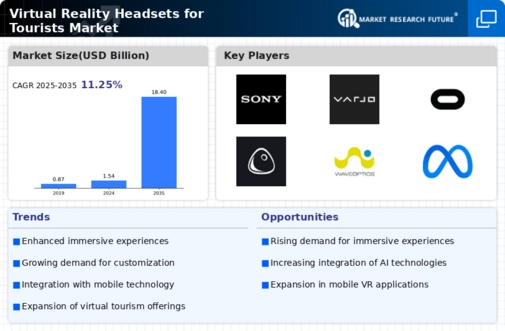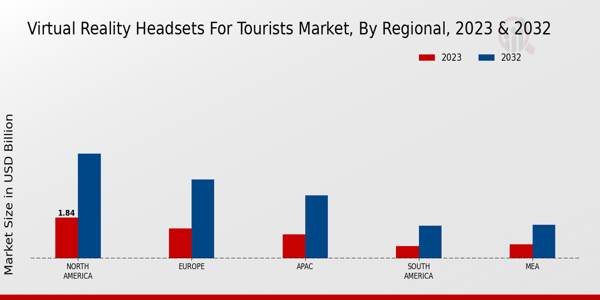Growing Tourism Sector
The Global Virtual Reality Headsets for Tourists Market Industry benefits from the expanding tourism sector, which is increasingly adopting innovative technologies to enhance visitor experiences. As global travel continues to rebound, destinations are integrating virtual reality into their offerings, allowing tourists to preview attractions or engage in immersive experiences. This trend is evident in various tourist hotspots, where VR experiences are becoming a staple. The anticipated growth of the tourism sector is expected to contribute significantly to the market, with estimates suggesting a rise to 18.4 USD Billion by 2035. This growth reflects the increasing recognition of VR as a valuable tool for enhancing tourist engagement.
Market Growth Projections
The Global Virtual Reality Headsets for Tourists Market Industry is poised for substantial growth, with projections indicating a market value of 1.54 USD Billion in 2024. This growth trajectory is supported by a compound annual growth rate of 25.28% from 2025 to 2035, reflecting the increasing integration of VR technology in the tourism sector. As more consumers seek immersive experiences, the demand for VR headsets is likely to rise, driven by advancements in technology and the growing awareness of VR's benefits. The market's expansion is indicative of a broader trend towards innovative solutions in tourism, suggesting a promising future for VR in this industry.
Technological Advancements
The Global Virtual Reality Headsets for Tourists Market Industry is experiencing rapid technological advancements that enhance user experience. Innovations in display technology, such as higher resolution and improved field of view, are making virtual reality experiences more immersive. For instance, the introduction of wireless headsets has eliminated the constraints of cables, allowing users to explore virtual environments freely. These advancements are expected to drive market growth, with projections indicating a market value of 1.54 USD Billion in 2024. As technology continues to evolve, the demand for sophisticated VR headsets among tourists is likely to increase, further propelling the industry forward.
Increased Consumer Awareness
Increased consumer awareness regarding the benefits of virtual reality is driving the Global Virtual Reality Headsets for Tourists Market Industry. Tourists are becoming more informed about the immersive experiences that VR can offer, such as virtual tours of historical sites or interactive cultural experiences. This heightened awareness is leading to a greater willingness to invest in VR technology, as consumers seek unique and memorable experiences during their travels. As a result, the market is likely to witness a compound annual growth rate of 25.28% from 2025 to 2035, indicating a robust demand for VR headsets among tourists who prioritize innovative experiences.
Diverse Applications in Tourism
The diverse applications of virtual reality in tourism are significantly influencing the Global Virtual Reality Headsets for Tourists Market Industry. VR is being utilized for various purposes, including virtual tours, educational experiences, and entertainment, catering to a wide range of tourist interests. For instance, museums and historical sites are using VR to create engaging narratives that enhance visitor understanding. This versatility is appealing to both tourists and service providers, leading to increased adoption of VR technology. As the market evolves, it is projected to grow substantially, potentially reaching 18.4 USD Billion by 2035, driven by the expanding applications of VR in the tourism sector.
Integration with Travel Services
The integration of virtual reality with travel services is emerging as a key driver for the Global Virtual Reality Headsets for Tourists Market Industry. Travel agencies and tour operators are increasingly incorporating VR experiences into their packages, allowing potential travelers to experience destinations before booking. This not only enhances customer satisfaction but also aids in decision-making. For example, some travel companies offer VR previews of vacation spots, which can significantly influence consumer choices. As this trend continues, the market is expected to expand, with a projected value of 1.54 USD Billion in 2024, reflecting the growing synergy between VR technology and travel services.
























Leave a Comment